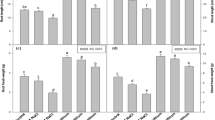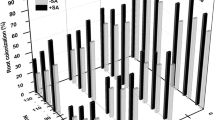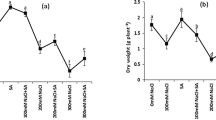Abstract
Salinization of farming soils is a major abiotic stress hampering crop growth and productivity globally. Chickpea is a vital legume crop, being cultivated largely in rainfed drylands and is sensitive to salt stress. Salicylic acid (SA) is an important signalling molecule, which improves plant stress tolerance; nevertheless, the underlying mechanisms behind SA-mediated defence responses under salt stress, especially in chickpea, are unclear. Thus, pot experiments were carried out to investigate the role of SA (0.5 mM) seed priming on growth, nitrogen fixation, photosynthesis, ROS production, antioxidant defence system and yield in two chickpea (Cicer arietinum L.) genotypes (GPF-2 and PBG-7) subjected to salt stress (80 mM). Results revealed that salinity stress reduced the nodulation, nitrogen fixation (leghemoglobin content), photosynthetic pigments and growth, which eventually affected yield output, more in PBG-7 than in GPF-2. Despite the enhanced antioxidant mechanisms [superoxide dismutase, catalase, peroxidase, phenols, proline, lignin] under salt stress, ROS (O2•− and H2O2) accumulation increased significantly and induced lipid peroxidation and electrolyte leakage. However, pre-soaking (priming) of SA retained biomass, photosynthetic efficiency, arrested nodule senescence and decreased oxidative stress via enhanced stimulation of ROS scavenging machinery, consequently increasing the productivity in a genotype-dependent manner. Our study emphasized the use of SA-seed priming as an eco-friendly approach for improving salt tolerance and accomplishing sustainable production of chickpea genotypes in salt-affected soils.




Similar content being viewed by others
References
Acosta-Motos J, Ortuño M, Bernal-Vicente A, Diaz-Vivancos P, Sanchez-Blanco M, Hernandez J (2017) Plant responses to salt stress: adaptive mechanisms. Agronomy 7(1):18
Al-Chammaa M, Al-Ain F, Kurdali F (2019) Effect of salicylic acid on growth, nodulation and N2-fixation in water stressed chickpeas using 2N and 13C. Adv Horti Sci 33(3):391–401
Almagro L, Gómez Ros LV, Belchi-Navarro S, Bru R, Ros Barceló A, Pedreño MA (2009) Class III peroxidases in plant defence reactions. J Exp Bot 60(2):377–390. https://doi.org/10.1093/jxb/ern277
Asensi-Fabado MA, Cela J, Müller M, Arrom L, Chang C, Munné-Bosch S (2012) Enhanced oxidative stress in the ethylene-insensitive (ein3-1) mutant of Arabidopsis thaliana exposed to salt stress. J Plant Physiol 169(4):360–368. https://doi.org/10.1016/j.jplph.2011.11.007
Babar S, Siddiqi EH, Hussain I, Bhatti KH, Rasheed R (2014) Mitigating the effects of salinity by foliar application of salicylic acid in Fenugreek. Physiol J Article ID 869058
Bharti A, Garg N (2019) SA and AM symbiosis modulate antioxidant defense mechanisms and asada pathway in chickpea genotypes under salt stress. Ecotoxicol Environ Saf 178:66–78. https://doi.org/10.1016/j.ecoenv.2019.04.025
Bradford MM (1976) A rapid and sensitive method for the quantification of microgram quantities of protein utilizing the principle of protein dye–binding. Anal Biochem 72:248–254
Cao WH, Liu J, He XJ, Mu RL, Zhou HL, Chen SY, Zhang JS (2007) Modulation of ethylene responses affects plant salt-stress responses. Plant Physiol 143:707–719
Czarnocka W, Karpiński S (2018) Friend or foe? Reactive oxygen species production, scavenging and signaling in plant response to environmental stresses. Free Rad Biol Med 122:4–20
Egamberdieva D, Wirth SJ, Shurigin VV, Hashem A, Abd_Allah EF (2017) Endophytic bacteria improve plant growth, symbiotic performance of chickpea (Cicer arietinum L.) and induce suppression of root rot caused by Fusarium solani under salt stress. Front Microbiol 8: 1887
Elhakem A (2020) Salicylic acid ameliorates salinity tolerance in maize by regulation of phytohormones and osmolytes. Plant Soil Environ 66(10):533–541
El-Hamid EMA, Sadak MS (2012) Performance of flax cultivars in response to exogenous application of salicylic acid under salinity stress. J App Sci Res 8(10):5081–5088
El-Katony TM, El- Bastawisy ZM, El-Ghareeb SS (2019) Timing of salicylic acid application affects the response of maize (Zea mays L.) hybrids to salinity stress. Heliyon 5:e01547
FAOSTAT (2019) http://www.fao.org/faostat/en/#data/QCL
Flowers TJ, Galal HK, Bromham L (2010) Evolution of halophytes: multiple origins of salt tolerance in land plants. Funct Plant Biol 37(7):604–612
Garg N, Bharti A (2018) Salicylic acid improves arbuscular mycorrhizal symbiosis and Cicer arietinum growth and yield by modulating carbohydrate metabolism under salt stress. Mycorrhiza 28(8):727–746
Garg N, Manchanda G (2008) Effect of arbuscular mycorrhizal inoculation on salt-induced nodule senescence in Cajanus cajan (pigeonpea). J Plant Growth Regul 27(2):115–124
Gharbi E, Lutts S, Dailly H, Quinet M (2018) Comparison between the impacts of two different modes of salicylic acid application on tomato (Solanum lycopersicum) responses to salinity. Plant Signal Behav 13(5):e1469361
Gutsch A, Sergeant K, Keunen E, Prinsen E, Guerriero G, Renaut J, Hausman J-F, Cuypers A (2019) Does long-term cadmium exposure influence the composition of pectic polysaccharides in the cell wall of Medicago sativa stems? BMC Plant Biol 19:271
Hao L, Zhao Y, Jin D, Zhang L, Bi X, Chen H, Xu Q, Ma C, Li G (2012) Salicylic acid-altering Arabidopsis mutants response to salt stress. Plant Soil 354:81–95
Hayat S, Hayat Q, Alyemeni MN, Ahmad A (2014) Salicylic acid enhances the efficiency of nitrogen fixation and assimilation in Cicer arietinum plants grown under cadmium stress. J Plant Interact 9(1):35–42
Ilyas M, Nisar M, Khan N, Hazrat A, Khan AH, Hayat K, Fahad S, Khan A, Ullah A (2021) Drought tolerance strategies in plants: a mechanistic approach. J Plant Growth Regul 40(3):926–944
Irigoyen JJ, Emerich DW, Sanchez-Diaz M (1992) Water stress induced changes in concentrations of proline and total soluble sugars in nodulated alfalfa (Medicago sativa) plants. Physiol Plant 84:55–60
Jayakannan M, Bose J, Babourina O, Rengel Z, Shabala S (2015) Salicylic acid in plant salinity stress signalling and tolerance. Plant Growth Regul 76:25–40
Jia XM, Zhu YF, Hu Y, Zhang R, Cheng L, Zhu ZL, Zhao T, Zhang X, Wang YX (2019) Integrated physiologic, proteomic, and metabolomic analyses of Malus halliana adaptation to saline–alkali stress. Hortic Res 6(1):1–19
Jukanti AK, Gaur PM, Gowda CLL, Chibbar RN (2012) Nutritional quality and health benefits of chickpea (Cicer arietinum L.): a review. British J Nutr 108:S11–S26
Kangasjärvi S, Neukermans J, Li S, Aro EM, Noctor G (2012) Photosynthesis, photorespiration, and light signalling in defence responses. J Exp Botany 63(4):1619–1636
Khan MIR, Khan N (2017) Reactive oxygen species and antioxidant systems in plants: role and regulation under abiotic stress. Springer. https://doi.org/10.1007/978-981-10-5254-5
Khan MIR, Asgher M, Khan NA (2014) Alleviation of salt-induced photosynthesis and growth inhibition by salicylic acid involves glycinebetaine and ethylene in mungbean (Vigna radiata L.). Plant Physiol Biochem 80:67–74
Khan MIR, Fatma M, Per TS, Anjum NA, Khan NA (2015) Salicylic acid-induced abiotic stress tolerance and underlying mechanisms in plants. Front Plant Sci 6:462
Khan HA, Siddique KHM, Colmer TD (2016) Salt sensitivity in chickpea is determined by sodium toxicity. Planta
Kim Y, Mun B-G, Khan AL, Waqas M, Kim H-H, Shahzad R, Imran M, Yun B-W, Lee I-J (2018) Regulation of reactive oxygen and nitrogen species by salicylic acid in rice plants under salinity stress conditions. PLoS One 13(3):e0192650
Li T, Hu YY, Du XH, Tang H, Shen CH, Wu JS (2014) Salicylic acid alleviates the adverse effects of salt stress in Torreya grandis cv. Merrillii seedlings by activating photosynthesis and enhancing antioxidant systems. PLoS One 9:e109492
Liu H, Zhang C, Yang J, Yu N, Wang E (2018) Hormone modulation of legume-rhizobial symbiosis. J Integ Plant Biol 60(8):632–648
Ludwiczak A, Osiak M, Cárdenas-Pérez S, Lubinska-Mielinska S, Piernik A (2021) Osmotic stress or ionic composition: which affects the early growth of crop species more? Agron 11:435
Ma X, Zheng J, Zhang X, Hu Q, Qian R (2017) Salicylic acid alleviates the adverse effects of salt stress on Dianthus superbus (Caryophyllaceae) by activating photosynthesis, protecting morphological structure, and enhancing the antioxidant system. Front Plant Sci 8:600
Majeed S, Akram M, Latif M, Ijaz M, Hussain M (2016) Mitigation of drought stress by foliar application of salicylic acid and potassium in mungbean (Vigna radiata L.). Legume Res-Int J 39(2):208–214
Manchanda G, Garg N (2011) Alleviation of salt-induced ionic, osmotic and oxidative stresses in Cajanus cajan nodules by AM inoculation. Plant Biosys 145(1):88–97
Meloni DA, Oliva MA, Ruiz HA, Martinez CA (2001) Contribution of proline and inorganic solutes to osmotic adjustment in cotton under salt stress. J Plant Nutr 24:599–612
Mhadhbi H, Fotopoulos V, Mylona PV, Jebara M, Elarbi Aouani M, Polidoros AN (2011) Antioxidant gene–enzyme responses in Medicago truncatula genotypes with different degree of sensitivity to salinity. Physiol Plant 141(3):201–214
Munns R, Gilliham M (2015) Salinity tolerance of crops–what is the cost? New Phytol 208(3):668–673
Nahar K, Hasanuzzaman M, Fujita M (2016) Roles of osmolytes in plant adaptation to drought and salinity In: Iqbal N, Nazar R, Khan NA (eds), Osmolytes and plants acclimation to changing environment: Emerging omics technologies. Springer, pp 37–68
Negrão S, Schmöckel SM, Tester M (2017) Evaluating physiological responses of plants to salinity stress. Ann Bot 119:1–11
Novo-Uzal E, Gutiérrez J, Martínez-Cortés T, Pomar F (2014) Molecular cloning of two novel peroxidases and their response to salt stress and salicylic acid in the living fossil Ginkgo biloba. Ann Bot 114(5):923–936
Othman, MHC (2017) Unravelling the role of mitochondrial respiration in salinity tolerance of wheat. Doctoral thesis
Palma F, López-Gómez M, Tejera NA, Lluch C (2013) Salicylic acid improves the salinity tolerance of Medicago sativa in symbiosis with Sinorhizobium meliloti by preventing nitrogen fixation inhibition. Plant Sci 208:75–82
Park HJ, Kim WY, Yun DJ (2016) A new insight of salt stress signaling in plant. Mol Cell 39:447–459
Parvaiz A, Satyawati S (2008) Salt stress and phyto-biochemical responses of plants—a review. Plant Soil Environ 54(3):89–99
Peng Y, Yang J, Li X, Zhang Y (2021) Salicylic Acid: biosynthesis and signaling. Ann Rev Plant Biol 72:761–791
Pirasteh-Anosheh H, Emam Y, Rousta MJ, Ashraf M (2017) Salicylic acid induced salinity tolerance through manipulation of ion distribution rather than ion accumulation. J Plant Growth Regul 36(1):227–239
Poór P, Gémes K, Horváth F, Szepesi A, Simon ML, Tari I (2011) Salicylic acid treatment via the rooting medium interferes with stomatal response, CO2 fixation rate and carbohydrate metabolism in tomato, and decreases harmful effects of subsequent salt stress. Plant Biol 13(1):105–114
Poór P, Borbely P, Bodi N, Bagyanszki M, Gorgenyi Tari I (2019a) Effects of salicylic acid on photosynthetic activity and chloroplast morphology under light and prolonged darkness. Photosyn 57:367–376
Poór P, Czékus Z, Tari I, Ördög A (2019b) The multifaceted roles of plant hormone salicylic acid in endoplasmic reticulum stress and unfolded protein response. Int J Mol Sci 20(23):5842
Pushpavalli R, Quealy J, Colmer TD, Turner NC, Siddique KH, Rao MV, Vadez V (2016) Salt stress delayed flowering and reduced reproductive success of chickpea (Cicer arietinum L.), a response associated with Na+ accumulation in leaves. J Agron Crop Sci 202(2):125–138
Qadir M, Quille’rou E, Nangia V, Murtaza G, Singh M, Thomas RJ, Drechsel P, Noble AD (2014) Economics of salt-induced land degradation and restoration. Nat Res Forum 38(4):282–295
Qureshi M, Abdin M, Ahmad J, Iqbal M (2013) Effect of long-term salinity on cellular antioxidants, compatible solute and fatty acid profile of sweet Annie (Artemisia annua L.). Phytochem 95:215–223
Rasheed F, Anjum NA, Masood A, Sofo A, Khan NA (2020) The key roles of salicylic acid and sulfur in plant salinity stress tolerance. J Plant Growth Regul. https://doi.org/10.1007/s00344-020-10257-3
Richard LA (1954) Diagnosis and Improvement of Saline and Alkali Soils, United states Department of Agriculture, Soil and Water Conservation Research Branch, Agricultural Research Service, Agriculture Handbook No. 60. US Government Printing Office, Washington 25, DC
Safari M, Mousavi-Fard S, Nejad AR, Sorkheh K, Sofo A (2021) Exogenous salicylic acid positively affects morpho-physiological and molecular responses of Impatiens walleriana plants grown under drought stress. Int J Environ Sci Technol. https://doi.org/10.1007/s13762-020-03092-2
Segev A, Badani H, Kapulnik Y, Shomer T, Oren- Shamir M, Galili S (2010) Determination of polyphenols, flavonoids, and antioxidants capacity in colored chickpea (Cicer arietinum L.). J Food Sci 75(2):115–119
Sharma A, Shahzad B, Kumar V, Kohli SK, Sidhu GPS, Bali AS, Handa N, Kapoor D, Bhardwaj R, Zheng BS (2019) Phytohormones regulate accumulation of osmolytes under abiotic stress. Biomolecules 9:285–320
Sharma V, Bhattacharyya S, Kumar R, Kumar A, Ibañez F, Wang J, Guo B, Sudini HK, Gopalakrishnan S, DasGupta M, Varshney RK, Pandey MK (2020) Molecular basis of root nodule symbiosis between Bradyrhizobium and ‘Crack-Entry’ legume groundnut (Arachis hypogaea L.). Plants 9(2):276
Sharma A, Sidhu GPS, Araniti F, Bali AS, Shahzad B, Tripathi DK, Brestic M, Skalicky M, Landi M (2020b) The role of salicylic acid in plants exposed to heavy metals. Molecules 25:540–562
Shimoda Y, Nishigaya Y, Yamaya-Ito H, Inagaki N, Umehara Y, Hirakawa H, Sato S, Yamazaki T, Hayashi M (2020) The rhizobial autotransporter determines the symbiotic nitrogen fixation activity of Lotus japonicus in a host-specific manner. PNAS 117(3):1806–1815
Singh R, Hemantaranjan A, Patel PK (2015) Salicylic acid improves salinity tolerance in field pea (Pisum sativum L.) by intensifying antioxidant defense system and preventing salt-induced nitrate reductase (NR) activity loss. Legume Res Int J 38(2):202–208
Stacey G, McAlvin CB, Kim SY, Olivares J, Soto MJ (2006) Effects of endogenous salicylic acid on nodulation in the model legumes Lotus japonicus and Medicago truncatula. Plant Physiol 141(4):1473–1481
Syeed S, Anjum NA, Nazar R, Iqbal N, Masood A, Khan NA (2011) Salicylic acid-mediated changes in photosynthesis, nutrients content and antioxidant metabolism in two mustard (Brassica juncea L.) cultivars differing in salt tolerance. Acta Physiol Plant 33(3):877–886
Tari I, Csiszár J, Horváth E, Poór P, Takács Z, Szepesi Á (2015) The alleviation of the adverse effects of salt stress in the tomato plant by salicylic acid shows a time-and organ-specific antioxidant response. Acta Biol Crac Ser Bot 57(1):21–30
Torre-González A, Navarro-León E, Albacete A, Blasco B, Ruiz JM (2017) Study of phytohormone profile and oxidative metabolism as key process to identification of salinity response in tomato commercial genotypes. J Plant Physiol 216:164–173
Torun H, Novák O, Mikulík J, Pěnčík A, Strnad M, Ayaz FA (2020) Timing-dependent effects of salicylic acid treatment on phytohormonal changes, ROS regulation, and antioxidant defense in salinized barley (Hordeum vulgare L.). Sci Rep 10:13886
Vadez V, Rashmi M, Sindhu K, Muralidharan M, Pushpavalli R, Turner NC, Krishnamurthy L, Gaur PM, Colmer TD (2012) Large number of flowers and tertiary branches, and higher reproductive success increase yields under salt stress in chickpea. Eur J Agron 41:42–51
Yang Y, Guo Y (2018) Elucidating the molecular mechanisms mediating plant salt stress responses. New Phytol 217(2):523–539
Yu L-L, Liu Y, Zhu F, Geng X-X, Yang Y, He Z-Q, Xu F (2020) The enhancement of salt stress tolerance by salicylic acid pretreatment in Arabidopsis thaliana. Biol Plant 64:150–158
Zahra S, Amin B, Ali VSM, Ali Y, Mehdi Y (2010) The salicylic acid effect on the tomato (Lycopersicum esculentum Mill.) sugar, protein and proline contents under salinity stress (NaCl). J Biophy Struc Biol 2(3):35–41
Zaman M, Shahid SA, Pharis RP (2016) Salinity a serious threat to food security – where do we stand? Soils Newsletter 39:9–10
Zhao C, Zhang H, Song C, Zhu JK, Shabala S (2020) Mechanisms of plant responses and adaptation to soil salinity. Innovation 1(1):100017
Zörb C, Geilfus CM, Dietz KJ (2019) Salinity and crop yield. Plant Biol 21:31–38
Acknowledgements
The authors are grateful to Akal University for providing research facilities for carrying out the investigations. The authors also extend their sincere appreciation to the Researchers Supporting Project number (RSP-2021/347), King Saud University, Riyadh, Saudi Arabia.
Author information
Authors and Affiliations
Contributions
HK and MIRK involved in conceptualization and finalizing the manuscript. SJH, GK and HK participated in data curation. PP, SA and MHS analysed the data and helped in first draft.
Corresponding authors
Ethics declarations
Conflict of interest
The authors declare that they have no conflict of interest.
Additional information
Handling Editor: Peter Poor.
Publisher's Note
Springer Nature remains neutral with regard to jurisdictional claims in published maps and institutional affiliations.
Supplementary Information
Below is the link to the electronic supplementary material.
Rights and permissions
About this article
Cite this article
Kaur, H., Hussain, S.J., Kaur, G. et al. Salicylic Acid Improves Nitrogen Fixation, Growth, Yield and Antioxidant Defence Mechanisms in Chickpea Genotypes Under Salt Stress. J Plant Growth Regul 41, 2034–2047 (2022). https://doi.org/10.1007/s00344-022-10592-7
Received:
Accepted:
Published:
Issue Date:
DOI: https://doi.org/10.1007/s00344-022-10592-7




